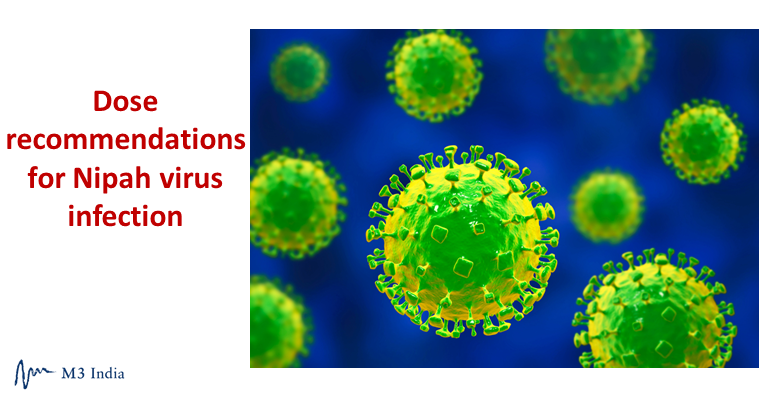Dose recommendations for Nipah virus infection
M3 India Newsdesk Jun 05, 2019
The entire country is once again grappled with the Nipah outbreak this year, more so because there is no approved treatment for it. However, scientists at National Institute of Virology, Pune, confirmed that ribavirin therapy reduces viremia in the Nipah virus infection.

The rare and deadly Nipah virus which has a mortality rate of up to 70% claimed approximately 17 lives in the state of Kerala. The Nipah virus was known to cause life-threatening conditions, encephalitis (inflammation of the brain) and serious respiratory system problems. However, the most alarming thing about the Nipah virus infection was that it had no approved treatment.
In the absence of an approved drug, ribavirin is the preferred first-line therapy for the potentially fatal Nipah virus infection.
The drug was found to be effective in controlling the spread of the virus in the body during the first Nipah virus outbreak in Malaysia in the year 1999. The drug acts by inhibiting the RNA replication of the Nipah virus, thereby reducing the viral load.
It is recommended that for the best outcome, the treatment with ribavirin must be started within 2-3 days of the appearance of symptoms. The recommended treatment regimen with ribavirin is tabulated below.
| Days | Dosage & Frequency of Ribavarin |
| Day 1 | 2 g single dose |
| Days 2-4 | 1.2 g, three times per day |
| Days 5-6 | 1.2 g, twice a day |
| Additional therapy for 1-4 days | 0.6 g, twice a day |
Not much research has been done on the use of ribavirin in treating the Nipah virus infection. Till date, only a single open-label trial has been reported, and recently in June 2018, the Indian scientists have worked to determine its effectiveness.
The open-label trial done in Malaysia demonstrated the effectiveness of ribavirin in treating the Nipah virus infection in terms of mortality rate. This study was conducted in 194 patients, 140 in ribavirin arm and 54 in the control arm. The control arm included patients who were managed without ribavirin or refused treatment. The mortality rate was found to be 32% in the ribavirin arm and 54% in the control arm.
This indicates that ribavirin treatment brings about 36% reduction in the mortality rate. Moreover, there were no reported associated side effects with ribavirin.
Recently in June 2018, the scientists at National Institute of Virology, Pune, confirmed that ribavirin reduces viremia in the Nipah virus infection.
It was concluded that ribavirin along with supportive therapy is effective in managing the Nipah virus infection.
The scientists evaluated the effectiveness of ribavirin using computer software models (in-silico study). The efficacy of other treatment options such as favipiravir, chloroquine, and neutralising antibodies has been studied in animals, but no research has been done yet in humans. However, in the absence of an approved treatment, ribavirin continues to be the drug of choice for treating the Nipah virus infection.
This article was previously published on June 26, 2018.
Disclaimer: While we have made every attempt to ensure that the information contained in this Site has been obtained from reliable sources, we are not responsible for any errors or omissions, or for the results obtained from the use of this information. Please use your own discretion.
-
Exclusive Write-ups & Webinars by KOLs
-
Daily Quiz by specialty
-
Paid Market Research Surveys
-
Case discussions, News & Journals' summaries